- 4771 ROUTE 71, OSWEGO, IL 60543
- (630) 554-8600
Dentures

Dentures are replacement teeth. Reasons for needing dentures might be an accident, an injury, a disease or a lack of oral care. Tooth loss requiring replacement teeth can sometimes have a hereditary factor as well.
Able to be fit into the upper jaw, lower jaw or both, custom dentures from Oswego Dental Group can accommodate conditions such as:
- gaps between teeth
- loose or shifting teeth
- chronic tooth aches & pains
- red, swollen, tender or bleeding gums
- one or more missing teeth
- difficulty eating certain types of foods
Tens of millions of Americans wear dentures. No specific age is associated with them, but people are more likely to need them as they get older.
Good oral hygiene and regular visits to Oswego Dental Group for dental cleanings can help maintain healthy teeth for longer, but if you have any conditions such as those right above, you can inquire with us about solutions such as dentures.
Types of Dentures
Dentures are available as two primary types: full (complete) and partial.
Full Dentures

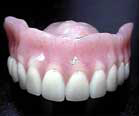
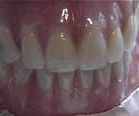
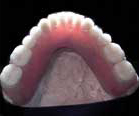
Full (complete) dentures replace an entire arch of missing teeth in an upper or lower jaw.
Full dentures are made of a gum tissue–colored acrylic base and natural-looking porcelain or acrylic teeth. Each full denture rests on the gums and is held in place by suction. The denture may also depend on the roof of the mouth or the lower jawbone for support.
While dentures can be worn without a denture adhesive, an adhesive can make them more stable and comfortable for eating, talking and smiling.
People with full dentures often remove them at night to clean them as well as to give their gums a rest.
Full dentures also can be either conventional or immediate.
Conventional dentures are full arches of replacement teeth that will typically be ready for placement several weeks after the teeth have been removed and the gums have healed.
Immediate dentures are made in advance and can be placed right after the teeth are removed. This allows an individual to maintain teeth while the gums are healing.
Because bones and gums shrink with time, particularly during the healing period, immediate dentures may often require more adjustments. For this reason, they should be considered only temporary until conventional complete dentures can be made.
Partial Dentures

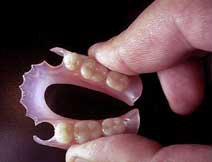
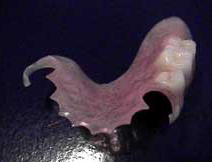
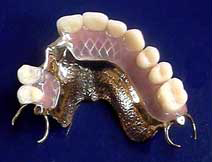
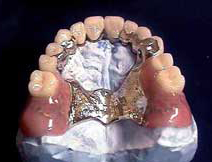
Partial Dentures replace some of the missing teeth in an arch (some good natural teeth remain). Like full dentures, they rely on the gums and underlying bone for support.
The replacement teeth are further held in place by “clasps,” which are support anchors that grip onto stable neighboring teeth and hold the appliance in place. The partial dentures help prevent the natural teeth from becoming loose and moving around as well.
Partial dentures, which are removable, can be made of tooth-colored acrylic attached to a pink or gum-colored base that may also be attached to a metal substructure.
Overdentures

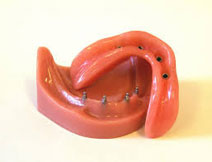
A patient with loose or ill-fitting dentures may become frustrated with them when trying to eat, talk or smile. In such a case, the patient may benefit from overdentures.
Able to be placed on both the upper and lower arches, overdentures are full dentures with tiny elastic fittings embedded in the areas contacting the gum tissue. The fittings fit snugly onto metal pegs (abutments) that emerge from the gum line. These pegs may be attached to a natural tooth, but they will more often be connected to an implant.
Most overdentures have between two and six abutments for providing proper stabilization. This solution is ideal for patients looking for a lower-cost alternative to an All-On-Four fixed bridge.
Dentures Near Me: How Are They Made?
Once we determine with you which appliance is best for you, we will then typically:
make impressions of your jaw
measure how your jaws relate to each other and how much space is between them
create models, wax forms or plastic patterns in the exact shape and position of the denture to be made
have you try the denture model several times so we can evaluate its color, shape and fit
cast the final denture
The process normally takes a few weeks. Once your final dentures are ready, we will make any adjustments to them as you might need. With proper care and maintenance, dentures can serve you well for as long as ten years.
Dentures Near Me: What Do They Feel Like?
At first, your new dentures might feel a bit loose as your tongue and cheek muscles adapt to keeping them in place. You’ll also adjust as you get used to inserting and removing them.
You might also initially experience minor irritation or soreness and an increase in saliva flow. These factors will diminish as the mouth becomes more acclimated.
Dentures from Oswego Dental Group are made to closely resemble your natural teeth, so you should notice only a minor change in appearance. In many cases new dentures help improve the smile and fill out the facial profile.
Dentures Near Me: How Often Must I Wear Them?
Your Oswego Dental Group dentist will consult with you as to how long you’ll want to wear your dentures and when to remove them.
For the first few days after you receive your appliance, we might advise you to wear it throughout the day, including as you sleep. Although it might be mildly (and briefly) uncomfortable, this is the quickest way to identify anything that might need modification.
Once any adjustments are made, you can continue wearing the dentures by day and removing them right before bed. This will let gum tissues rest and allow normal stimulation and cleansing by the tongue and saliva. The dentures can then be returned to the mouth in the morning.
Dentures Near Me: Contact Us Today
If you would like to further discuss how replacement teeth (dentures near me) from Oswego Dental Group can contribute to your dental comfort and function, or if you would like to arrange an appointment, call us at (630) 554-8600 or complete our contact form.
Dentures: Quick Facts
The earliest dentures were made of human or animal teeth in 700 B.C. by the Etruscans of ancient Italy.
The first porcelain dentures appeared in the 1700s; fragile and unnatural-looking, they didn’t catch on.
Dentures made of ivory from elephants, hippos and walruses became popular in the 1800s.
Today, more than 36 million Americans are edentulous (toothless).
Another 120 million are missing at least one tooth.


